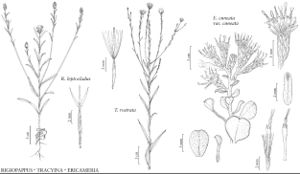Difference between revisions of "Tracyina rostrata"
Madroño 4: 75, fig. 1. 1937.
IllustratedEndemic
Treatment appears in FNA Volume 20. Treatment on page 50.
imported>Volume Importer |
imported>Volume Importer |
||
| Line 52: | Line 52: | ||
|publication year=1937 | |publication year=1937 | ||
|special status=Illustrated;Endemic | |special status=Illustrated;Endemic | ||
| − | |source xml=https:// | + | |source xml=https://bitbucket.org/aafc-mbb/fna-data-curation/src/2e0870ddd59836b60bcf96646a41e87ea5a5943a/coarse_grained_fna_xml/V19-20-21/V20_74.xml |
|tribe=Asteraceae tribe Astereae | |tribe=Asteraceae tribe Astereae | ||
|genus=Tracyina | |genus=Tracyina | ||
Latest revision as of 20:05, 5 November 2020
Leaf blades 10–25(–35+) × 1–2(–5+) mm. Peduncles ± pilosulous near heads. Involucres 5–7+ mm. Ray corollas: tubes 2.5–3+ mm, laminae narrowly elliptic, 1–1.5+ mm. Disc corollas: tubes 1–1.5 mm, throats 2–2.5 mm, lobes 0.1–0.3 mm. Cypselae 5–6 mm; pappi 1–4+ mm. 2n = 18.
Phenology: Flowering May–Jun.
Habitat: Grassy slopes
Elevation: 100–300+ m
Discussion
Selected References
None.
Lower Taxa
None.

